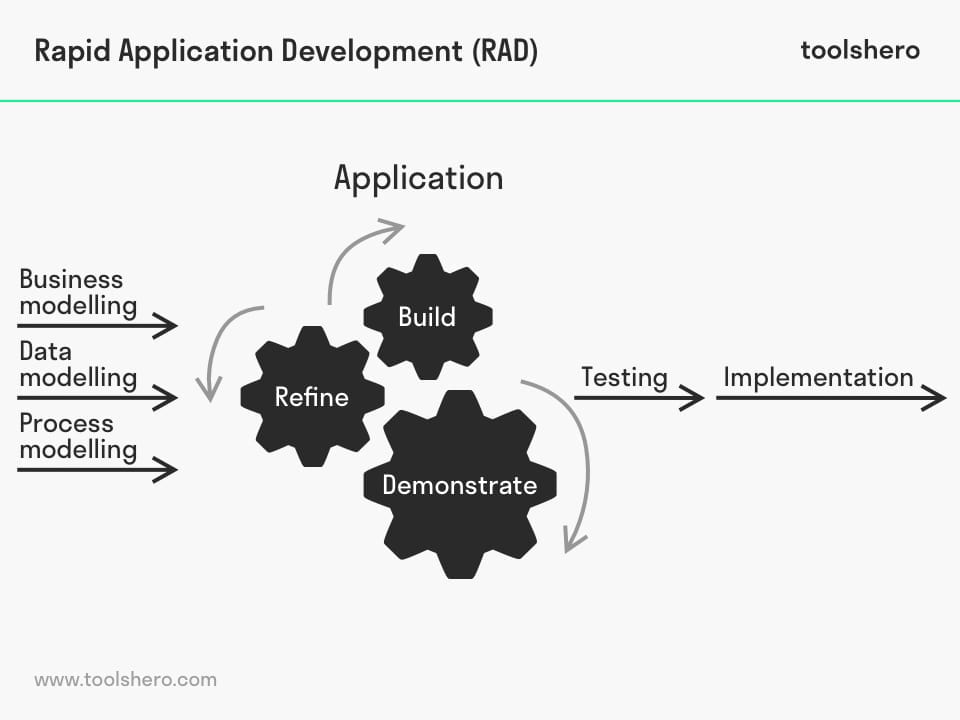Rapid Application Development (RAD)

Rapid Application Development (RAD): this article describes Rapid Application Development (RAD) in a practical way. Next to what it is (meaning and history), this article highlights it as an integrated system, it’s options to as as reusable, the RAD phases of the model design. After reading you will understand the basics of this project management and software development approach and method. Enjoy reading!
What is Rapid Application Development (RAD)? The meaning and history
Rapid Application Development (RAD) is a software development approach that uses minimal planning. In the 1980s RAD was developed by computer giant IBM.
Unlike the so-called Waterfall method, RAD enables organizations to develop software faster. The Waterfall method is based on phases that follow one another and merge into one another in the software development process as if they were a waterfall.
First there is the definition & analysis phase, then the system design phase followed by technical & detailed design, the architecture of the software, which leads to the testing phase, the integration of the software and it ends with maintenance and support.
RAD is a solution for non-flexible processes such as the Waterfall method. Building software applications in this ‘old-fashioned’ way, often took a long time, in which sometimes the requirements had already been changed before the entire system was developed and delivered. This sometimes resulted in unworkable applications.
Rapid Application Development as an integrated system
RAD is not about dependent phases but about simultaneous modular developments and introductions that allow a faster and better integration of the software system. The entire development process has already been integrated into the planning, and, where necessary, it can be supplemented, altered or refined.
RAD makes use of prototypes that serve as a working model that form an immediate part of the end product. RAD does use a detailed pre-planning phase, which makes it easier to incorporate changes in the development process.
A Rapid Application Development project consists of a small team of developers, experts and representatives from the customer to directly respond to the wishes and requirements of the customer that are used in developing the software.
Rapid Application Development and reusable
The main feature of RAD is that it embraces the reuse of the prototypes that have been developed. Therefore, there is little waste of time and effort.
Rapid Application Development focuses on the gathering of customer wishes and requirements through workshops, focus groups and prototypes the customer will test during the development process. Existing prototypes are reused as usable components. This creates a continuous integration of new components and enables a fast delivery to the customer.
Rapid Application Development: phases of the model design
The Rapid Application Development model divides the analysis, design, construction and the testing phases of the software development into a short series, which is developed in a cycle.

Figure 1 – Rapid Application Development Process
It consists of the following phases:
Business modelling
The specific business objective and principles of the business model must be clear in advance.
This makes clear what information needs to be distributed among the different business channels. A complete business analysis is performed to find vital information flows about the customer and how the information flow can be processed successfully.
Data modelling
All information that has been collected from the business model is assessed and analysed so that it will be of benefit to the customer.
The characteristics of all the data are identified and defined. The relationship between these data is recorded and identified and described in detail so that it will become relevant to the business model.
Process modelling
The object- data sets defined in the data model are converted into the business information flow which is necessary to achieve specific business objectives that are in accordance with the business model.
In this business model changes and improvements are implemented immediately. Also new process descriptions are added, unusable descriptions are removed or altered.
Application
The current software system has now been fully built and can be applied by means of coding and automation tools with which process and data models can be transformed into actual prototypes.
RAD Testing
The total RAD testing time is significantly reduced with Rapid Application Development, because prototypes have been previously tested independently of each other. This is done in a continuous process.
The information flow and the overlaps between the components must be tested thoroughly to ensure complete coverage. As most of the programming components have been tested before, it reduces the risk of potential problems at the end of the process.
Implementation
This is the phase were the new system is being deployed and introduced. This happens in earlier phases. The developed prototypes are used and there where needed adjusted, extended or further developed.
The prototype is the base for the end product. There are exceptional situations where the prototypes are totally redesigned. These situations hardly occur because the end-users are directly involved in the design of the prototype.
Benefits of Rapid Application Development
Rapid Application Development (RAD) is a concept that enables organizations to develop high-quality software systems more quickly. The important advantages to working with RAD are:
- Customer requirements can be gathered quickly through using focus groups and/or workshops.
- Working with usable prototypes enables early user testing.
- There is almost no wastage because software components can easily be reused.
- New developments and improvements can be implemented quickly in a next series.
- There is little to no waste of time.
It’s Your Turn
What do you think? Is the Rapid Application Development applicable in today’s modern IT environment businesses? Do you recognize the practical explanation or do you have more additions? What are your success factors regarding the RAD approach?
Share your experience and knowledge in the comments box below.
More information
- Mackay, H., Carne, C., Beynon-Davies, P., & Tudhope, D. (2000). Reconfiguring the user: using rapid application development. Social studies of science, 30(5), 737-757.
- McConnell, S. (1996). Rapid Development: Taming Wild Software Schedules. Microsoft Press.
- Viceconti, M., Zannoni, C., Testi, D., Petrone, M., Perticoni, S., Quadrani, P. & Clapworthy, G. (2007).The multimod application framework: a rapid application development tool for computer aided medicine. Computer methods and programs in biomedicine, 85(2), 138-151.
How to cite this article:
Mulder, P. (2017). Rapid Application Development (RAD). Retrieved [insert date] from Toolshero: https://www.toolshero.com/information-technology/rapid-application-development/
Original publication date: 02/22/2017 | Last update: 10/29/2023
Add a link to this page on your website:
<a href=”https://www.toolshero.com/information-technology/rapid-application-development/”>Toolshero: Rapid Application Development (RAD)</a>













One response to “Rapid Application Development (RAD)”
Great Post.